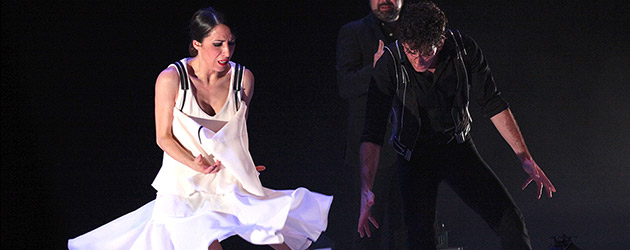Text: Estela Zatania
Photos: Ana Palma
Ballet Flamenco de Andalucía «Imágenes»
David Carpio, Manuel Valencia, Pablo Martín «Solos»
Thursday, March 5th, 2015. Jerez de la Frontera
Special 19th Festival de Jerez – All the information
Last night, a young singer showed what can be done with limited resources, well-prepared artists and an open mind, while the institutional flamenco of the great Ballet Flamenco de Andalucía didn't quite get it together.
In search of contemporary flamenco
DAVID CARPIO, MANUEL VALENCIA, PABLO MARTÍN «SOLOS»
Sala Paúl, 700pm
Cante: David Carpio. Guitar: Manuel Valencia. Upright bass: Pablo Martín. Guest artist (dance): Manuel Liñán
There's a new generation of flamenco singers who have inherited an economic crisis and value-added-tax of 21% that force them to reinvent themselves however they can. It's no longer «buenas noches», the bottle of mineral water and «put it on three por medio». Just since the Festival de Jerez began two weeks ago, we've seen original shows from Rocío Márquez and David Palomar, singers who manage to sell their product in attractive packaging to attract a broad audience, and David Lagos did the same thing last year within the Festival.
Jerez singer David Carpio has joined forces with guitarist Manuel Valencia, recently honored, and upright-bass-player Pablo Martín – the three have regularly worked together in Gerardo Núñez' group – to offer the most classic sort of flamenco in a way that is fresh and novel, and which appeals as much to the die-hard fan as the neophyte. The irrepressible Manuel Liñán, guest dancer, was also a key element. Four men, each one contributing his expertise, creativity and knowledge; it might not have worked…but it worked.
Carefully constructed transitions, a bass-player who really understands cante and knows how to accompany it, a dancer brimming with ideas and the singer from San Miguel, one of the most serious of his generation. Soleá, with no jazz harmony, nor any need for it, malagueñas with the bass accompanying perfectly. Tangos del Piyayo and of Triana for the dancing of Liñán who, being from Granada, works wonders with four-quarter time. Perhaps the most original moment, the siguiriyas and tonás David sang point-blank to the dancer who busied himself placing the singer's head, hand and arms adequately, as if the latter were a rag doll. Strictly traditional cante ingeniously updated with just a few simple gestures.
David left the stage singing, unaccompanied, the same dramatic soleá of Paquirri with which he had begun. And there was no bulerías fiesta finale.
BALLET FLAMENCO DE ANDALUCÍA «IMÁGENES: 20 AÑOS DE BALLET FLAMENCO DE ANDALUCÍA»
Teatro Villamarta, 900pm
Artistic director: Rafaela Carrasco. Choreography: Rafaela Carrascco, David Coria. Soloists: David Coria, Ana Morales, Hugo López. Corps de ballet: Rafael Carrasco, Ana Morales, Alejandra Gudí, Florencia O'Ryan, Laura Santamaría, Paula Comitre, Carmen Yanes, David Coria, Hugo López, Eduardo Leal, Antonio López, Alberto Sellés. Singers: Antonio Campos, Gabriel de la Tomasa. Guitar: Jesús Torres, Juan Antonio Suárez «Cano». Music directors: Antonio Campos, Jesús Torres, Juan Antonio Suárez «Cano».
It saddens me to think my beloved flamenco, which so efficiently fills my life with joy and emotion, should be officially presented to the world through what we saw last night at the Villamarta theater. Highly competent performers, beyond any doubt, but the overload of group dances, the extreme excess of footwork and the abuse of chest- and thigh-slapping was tedious and embarrassing. Educated applause throughout the work indicated I was not alone in my disappointment.
There was also relatively little flamenco singing, despite the presence of two fine interpreters, Antonio Campos and Gabriel de la Tomasa, who did what they could. Whatever wasn't full of foot-stomping was slow, obscure, cold, geometric, opaque and colorless. Depressing. The absence of flamenco feeling. So much talent and sacrifice put to so little effect.
When Ana Morales interpreted tangos, the first warm applause of the evening was finally forthcoming; people actually want to see flamenco. Towards the end, we were treated to singing, dancing, guitar, light and color in a series of dances and fragments of dances. Hugo López and Alberto Sellés generated sparks…bamberas, soleá petenera, caña…the audience awoke from its lethargy, flamenco is so energizing.
This work was awarded at the last Bienal de Sevilla with the Giraldillo for Best Show.
